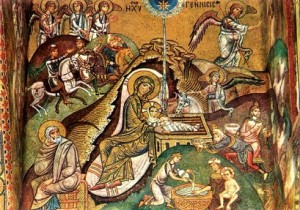“Carúl Loch Garman” è un antichissimo canto natalizio di origine irlandese risalente al XII secolo, popolare nella contea di Wexford (Irlanda del Sud) è conosciuto anche come The Enniscorthy Carol dal nome della cittadina da cui avrebbe avuto origine.
La sua diffusione ebbe luogo però nell’Ottocento con la trascrizione da parte di William Grattan Flood, all’epoca organista della cattedrale di San Aidan, che venne poi stampata nell'”Oxford Book of Carols” del 1928 (il must delle compilation natalizie). Se la melodia è medievale per il testo sono molto probabili rimaneggiamenti ottocenteschi sulla scia del “carols revival” del tempo.
La versione in gaelico con cui viene anche cantato – Carúl Loch Garman -non è tuttavia la più antica versione bensì una più recente traduzione, è infatti riportato nell’album “Ceol na Nollag” (Natale musica), 2002 pubblicato a Dublino da Cló Chaisil in collaborazione con Foras na Gaeilge (La lega Gaelica).
Nel libretto allegato (vedi pdf) il canto Enniscorthy Carol è tradotto in gaelico irlandese da M Cavanagh. La versione riporta solo due strofe incentrate sull’adorazione dei pastori.
CARÚL INIS CÓRTHAIDH, (Enniscorthy Carol) traduzione di M Cavanagh
[M Cavanagh version]
I
Ó, tagaig’ uile is adhraigí
An leanbh cneasta sa chró ‘na luí
Is cuimhnígí ar ghrá an Rí
A thug dár saoradh anocht an Naí.
‘S a Mhuire Mháthair i bParrthas Dé,
Ar chlann bhocht Éabha guigh ‘nois go caomh,
Is doras an chró ná dún go deo
Go n-adhram’ feasta Mac Mhuire Ógh.
II
I mBeithil thoir i lár na hoích’
Ba chlos an deascéala d’aoirí,
Go follas don saol ón spéir go binn
Bhí aingle ‘canadh ó rinn go rinn.
“Gluaisig’ go beo,” dúirt Aingeal Dé,
“Go Beithil sall is gheobhaidh sibh É
‘Na luí go séimh i mainséar féir,
Siúd É an Meisias a ghráigh an saol.”
[English translation]
“Carúl Loch Garman” is a very old Christmas carol of Irish origin dating back to the 12th century, popular in the county of Wexford (Southern Ireland). It is also known as The Enniscorthy Carol from the name of the town from which it originated.
Its diffusion took place in the nineteenth century with the transcription by William Grattan Flood, at the time organist of the cathedral of San Aidan, which was then printed in the “Oxford Book of Carols” of 1928 (the must of Christmas compilations) . If the melody is medieval, for the text it is very probable some nineteenth-century alterations in the wake of the “carols revival” of that time.
The Gaelic version with which it is also sung – Carúl Loch Garman – is not the oldest version but a more recent translation, it is reported in the album “Ceol na Nollag” (Christmas music), 2002 published in Dublin by Cló Chaisil in collaboration with Foras na Gaeilge (The Gaelic League). In the enclosed booklet (see pdf) the song Enniscorthy Carol is translated into Irish Gaelic by M Cavanagh. Only two verses focused on the worship of the shepherds has been translated.
Traduzione italiana Cattia Salto
I
Oh venite tutti ad adorare
il Re bambino che giace nella mangiatoia
e ricordate l’amore del Padre/ che ci diede
il bambinello stanotte per la nostra liberazione.
E sua Madre Maria nel Paradiso divino,
prega dolcemente per la povera famiglia di Eva
e non chiude la porta della grotta /affinchè si possa d’ora in poi adorare il figlio della vergine (1) Maria
II
Nella Betlemme orientale nel cuore della notte
la lieta novella fu udita dai pastori,
rivelata in Terra dal Cielo/gli angeli
soavemente cantavano da stella a stella
“Andate presto- disse l’Angelo del Signore –
all’estremo opposto di Betlemme e lo troverete
disteso quietamente sulla paglia della mangiatoia (2) , questo è il Messia che il mondo ama”
Note alla traduzione
(1) il riferimento non è tanto alla giovane età di Maria quanto piuttosto alla sua verginea fanciullezza. La verginità di Maria venne attestata dalle due levatrici Zelomi e Salome, presenti alla nascita secondo i vangeli apocrifi.
(2) anche qui ho preferito utilizzare un termine che più richiama il presepe tradizionale
English version by Stiofán Ó Briain
I
Oh, come all and adore
The kind baby in the stable lying down
And remember the love of the King
Who gave the infant tonight for our liberation.
And his Mother Mary in God’s Paradise,
Pray gently for Eve’s poor family,
And never close the stable door
That I may henceforth worship the Son of Young Mary.
II
In eastern Bethlehem in the middle of the night
The good news was heard by shepherds
Revealing to the world from the sky sweetly
angels were singing from star to star
“Move quickly, ” said God’s Angle,
“To the far side of Bethlehem and you’ll find him
lying softly in manger grass,
That is the Messiah that the world loves.”

The Enniscorthy carol
CARÚL INIS CÓRTHAIDH (irish Gaelic version)
WEXFORD LULLABY (John Renbourn )
LET ALL THAT ARE TO MIRTH INCLINED (English version)
WEXFORD CAROL (Irish version, William Grattan Flood)
